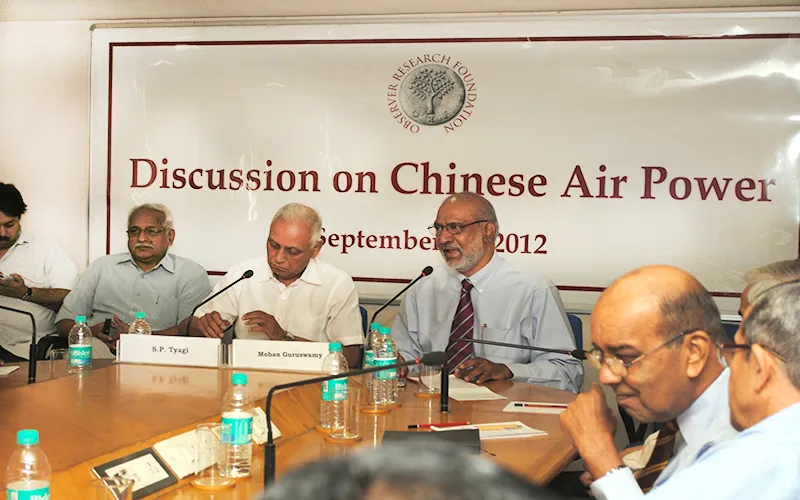-
CENTRES
Progammes & Centres
Location
Noting that the objective of the armed forces is not to win wars but to prevent wars, there was a consensus at an ORF discussion that India needs to overcome its deficiencies in order to create a credible deterrence.

Recognising the growing economic might of China and its rapid militarisation programme, Observer Research Foundation held a discussion on the "Chinese Air Power" on September 4, 2012. The objective of the meeting was to develop a better understanding of the strengths and weaknesses of the PLA Air Force (PLAAF). Air Marshall M. Matheswaran and Air Chief Marshall (retd) S.P. Tyagi initiated the discussion by making presentations on the PLAAF.
It was noted that despite India being the third largest economy in the world (in PPP terms), China’s sustained economic growth, both expected and in the past, has enabled the PLAAF to expand its capabilities in areas such as aircraft design and development.
Air Marshall Matheswaran elaborated on the history of the PLAAF from the days of its inception to its present programme of modernisation. He noted how the PLAAF was originally conceived as an auxiliary force to the People’s Liberation Army (PLA) under the leadership of Mao Tze Dong. China’s doctrine of the time, the People’s War, had a defensive outlook. Subsequently, under Deng Xiaoping, the PLAAF saw its role expand beyond the aegis of the PLA to incorporate it as a service to be utilized beyond its then capability as merely a support force for the army. Deng understood the need for the military to develop long-term technology and envisaged the PLAAF as an integral part of China’s power projection and quick reaction capabilities.
The need to develop the PLAAF was seen to be critical in China’s ability to gain a position of dominance in Asia. Air Marshall Matheswaran explained that China had begun to change its doctrinal stance from a defensive to a more offensive posture. Understanding that the possibility of a nuclear conflict was unlikely, he asserted that China began focusing on the development of conventional military capabilities for limited, localized wars. The PLAAF will be crucial in rapid reaction for military conflicts along their periphery, he noted.
Since 2004, the role of the Chinese air force was seen as central to China’s military might. With concentrated wars being central to the role of the PLAAF, stealth and surprise became a very crucial aspect in asserting this superiority. The discussion also highlighted the Chinese leadership’s focus on developing conventional missiles and weaponry. The missiles, controlled by the Second Artillery Force, were significant in supporting the PLAAF’s dominant role during a military conflict.
As witnessed earlier in history, the Chinese recognized the need to master critical technology. Beijing has made significant progress with capabilities such as air-to-air refueling and has also focused on the development of helicopters, which is an important component of its rapid reaction capability.
Another point of concern for India, which was revealed in the discussion, was China’s growing capability in space, especially its recent demonstration of the manned space flight. It has been estimated that China will have between 90 to 100 satellites in orbit by 2020. It is also developing its very own Beidou satellite navigation system which will ensure that it does not have to rely on the American GPS or the Russian GLONASS. It is expected that its ASAT capability will also be integral to its strategy.
However, the discussion did not paint an absolutely grim picture for India. It was argued that the high Himalayan mountain ranges formed a natural barrier and their narrow valleys make it a difficult area to manoeuvre through. Also, the high altitude of the Chinese airfields meant that they have certain limitations to their operational capability. Nonetheless, the ensuing discussions revealed that there are deficiencies that India needs to address. The threat of the Second Artillery is a cause for concern; India will need to develop a similar model for its missile forces. The inadequate development of India’s military-industrial complex was also a serious problem that was pointed out in the discussion. Creation of an Aerospace Committee to boost the aerospace sector was also suggested.
Noting that the objective of the armed forces is not to win wars but to prevent wars, there was a consensus that India needs to overcome its deficiencies in order to create a credible deterrence. The discussion was attended by government officials, members of the strategic community and the ORF faculty.
(This report is prepared by Arvind John, Research Assistant, Observer Research Foundation)
The views expressed above belong to the author(s). ORF research and analyses now available on Telegram! Click here to access our curated content — blogs, longforms and interviews.